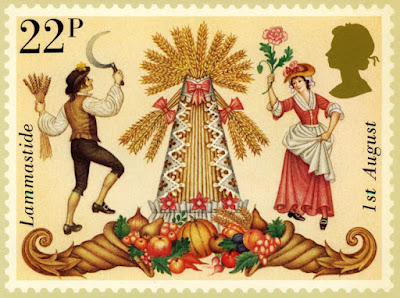The Scottish pre-wedding ritual known as blackening
practiced in the Highlands, Islands and rural parts of Scotland is a strange wedding tradition. In my book, it is disgusting. The groom and/or bride are publicly
taken out and drenched with a wide array of ingredients like
slop, molasses, flour, feathers, as well as smelly disgusting things like fish
guts and cow dung. I’ve read that this practice as it is done today is actually a corrupted
variation of an old foot washing/hair washing tradition when the purpose of the
blackening was to ensure the groom was dirty before the washing. How could today's blackening tradition be related to foot washing?
Blackening foot washing
I did some digging and found answers in “A Highland Wedding in Bygone Days” published in The Celtic Magazine, Vol. 13., 1888. The origins of the blackening tradition can be traced to a foot washing custom. In this case, the foot washing took place the night before the wedding and involved the groom. He and his friends gathered at his house using the guise of washing his feet for his wedding. Just like many bachelor parties today, a good deal of practical joking took place. One of these jokes included using soot, dirt, and other blackening agents mixed with the water and rubbed on the feet and even on the face of the bridegroom.
If the groom was fortunate enough to escape, his friends chased him down, and if he was lucky enough to find a good hiding place and eluded them, it was considered a good omen of future prosperity. When his friends gave up looking for him, he spent the rest of the night dancing.
Wedding shoes custom
On the Monday night after the first public announcement of their impending marriage the young couple secretly visited the shoemaker for the marriage shoes. The groom paid for both pairs. (In Greece it is still tradition for the groom to buy the bride’s shoes). They were delivered the morning of the wedding with money tucked inside, and if the groom delivered the shoes himself, he took the time to put them on her feet. However, it was perfectly acceptable for someone else to deliver the shoes.
As for the money in the shoes, this differs from the longstanding tradition of placing a lucky Sixpence in the bride’s shoe because that is done by the bride’s father as a symbol of prosperity, love and unity. However, there is another Scottish wedding tradition in which the groom popped a silver coin under his left foot. I don’t have any more info on what money the groom slipped into her shoe or why, but if I learn more, I’ll be sure to update this section.
Other Scottish wedding superstitions
As long as we are looking back at the history of Scottish wedding traditions/superstitions, here are a few lesser-known wedding superstitions once practiced in Scotland:
- Unlucky to get married in May
- Tuesdays and Thursdays were favored for weddings because the rest of the days were thought to be unlucky.
- A day during the waxing moon was always preferred.
- When the bride entered her new house for the first time she had to be careful to step over the threshold if she would be lucky.
- A cake of bread and a cheese, both of which had been previously either broken or cut into pieces, were placed on a plate and thrown over the bride’s had as she entered the door. If the plate broke it was a good omen as to having a son as heir.
* * *
Some links in this post are affiliate links. We are a participant in the Amazon Services LLC Associates Program, an affiliate advertising program designed to provide a means for us to earn fees by linking to amazon.com and affiliate sites.












